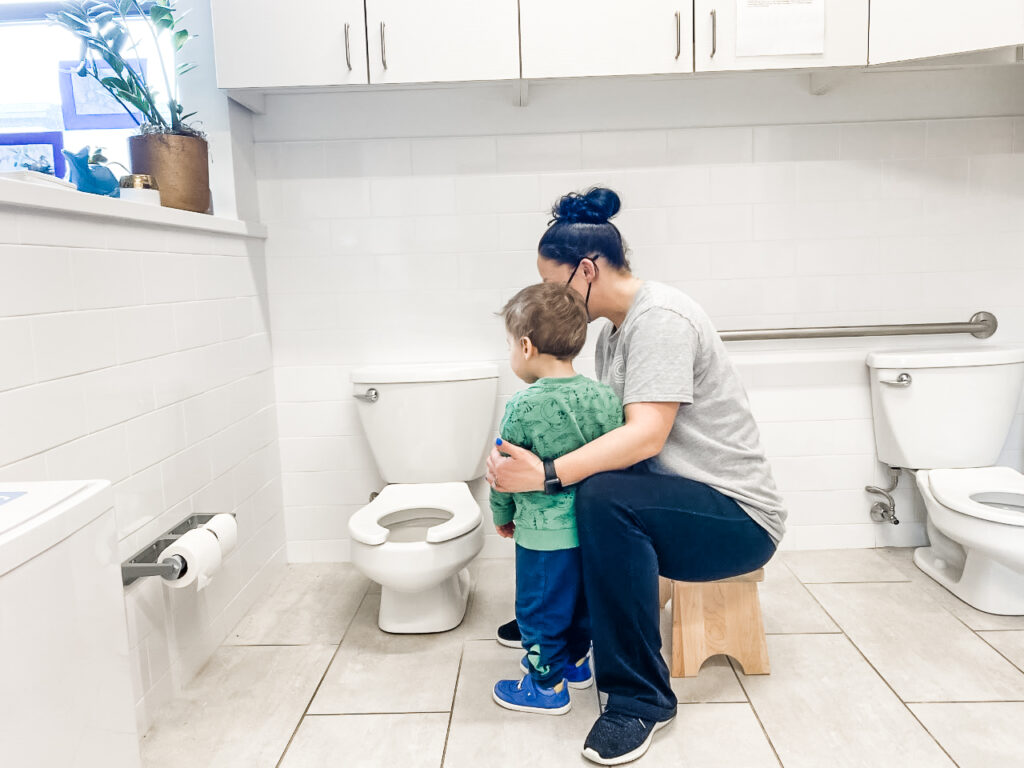Consistency and routine are important for children in many aspects of life, including toilet learning! At Ethos, the best success we have seen was when both the parent and teacher team up to take on this journey together, and when there is a consistent routine at home and at school.
In this post, we share how Ethos approaches the toilet learning process and what you can do at home so we can all be as consistent as possible. Our goal is that when you think your child is ready to learn to use the toilet, you are also ready to reach out to your child’s teachers to begin creating a plan together!
As explained in our previous posts about toilet learning, most children develop muscle control to regulate themselves between 18 months and 3 years, but you can set the stage for success as early as 6 months. Click here to read more about pre-toilet preparations and signs that indicate that your child is ready.

Setting the Scene
At school
At Ethos, our toilets are made just for your child! Small in size and as realistic as can be, your child’s experience using the toilet at school is adaptive to what they’ll do when they’re older.
Along with a realistic toilet experience, we also provide stools to use while on the toilet to support bowel safety, as well as a sitting place so they can undress with comfort.
At home
Your home potty should reflect a real toilet without the bells and whistles that are sometimes added to make it enticing. Less is more here!
Having an insert such as a stool or handles can be useful in supporting bowel safety and comfort as your child uses the toilet.
Supporting independence
At school
At Ethos, when children are in the process of toilet learning, we support their independence throughout the whole process — from pulling down their pants to washing their hands. Children are encouraged to practice the following steps by themselves:
- Take clothes to bathroom
- Take their clothes off
- Get on toilet and try to eliminate themselves
- Use toilet paper: wiping from front to back
- Get off the toilet
- Flush the toilet
- Get dressed again
- Wash hands
- If applicable, put dirty clothes away
At home
Children’s independence should be supported at home as well. Here are some things you can do to nurture independence at home:
- Have the clothes they may need for the day within reach so it is easy for them to get. It is a great idea to set up a special place where they can only get a couple of changes of clothes that you approve. Having fewer options available to them will make the cabinet easier to organize later if it becomes messy.
- Provide pants or shorts that are easy for children to pull up or down independently.
- Provide a stool so they can wash their hands independently and make sure the hand soap and towels are easy for your child to reach without your help.
Incorporating a routine
At school
Teachers ask children to use the toilet on regular intervals and allow children to take their time in the process, supervising the entire time for safety and hygienic purposes as well as providing reminders and support as needed.
At home
Ask your teacher about their routine and try to follow a similar routine at home. For instance, you may offer the potty/toilet before going outside, after coming in from outside, after lunch/before nap etc. As explained in our previous post about toilet learning, A natural time for our body’s need for excretion is 15 to 30 minutes after meals.
Dressing for success
At school
At Ethos, we avoid the use of pull-ups. The toilet learning process is all for learning about bodily sensations! When your child feels themselves wet, they will better understand why they need to use the toilet.
Terry cloth underwears are remarkably absorbent and as a result, more comfortable and gentler on the skin.
Clothing that is easy to remove by a child can support their independence and efforts in this process. Pants and shorts with elastic bands at the waist are best. Skirts, overalls and jeans are cute, but may get in the way and are hard to pull up or down.
At home
- Avoid or limit the use of pull-ups
- Opt for using terry cloth underwear
- Have your child wear easy-to-remove clothes
Avoiding rewards and punishments
At school
If a child wets their clothes or misses the toilet, it is not seen as an accident, but as a normal part of the toilet learning process.
While children are toilet learning, they are not given rewards for using the toilet (after all, this is a norm for humans!- it’s what we are supposed to do!). Instead, they are encouraged throughout to aid their confidence and efforts!
At home
We recommend following the same no rewards or punishments approach at home. Avoid getting emotionally involved and check our previous post for a list of Do’s and Don’ts when toilet learning your child.
While the aim is to have children master toilet learning by three years old, it’s okay if they haven’t! Just like all other skills, the pace and rate of mastery are different. Bed wetting, in general, continues to happen until age 6!
If you have any other questions feel free to reach out to us or your teachers! We are always here for you.
Till Next Post,
Aleezeh Makani
Ethos Early Learning Center Educator
Ethos Early Learning Center offers year-round child care and early childhood education for children ages 0-5 in South Boston, Ma. request more information about our programs at ethoslearn.com/moreinfo